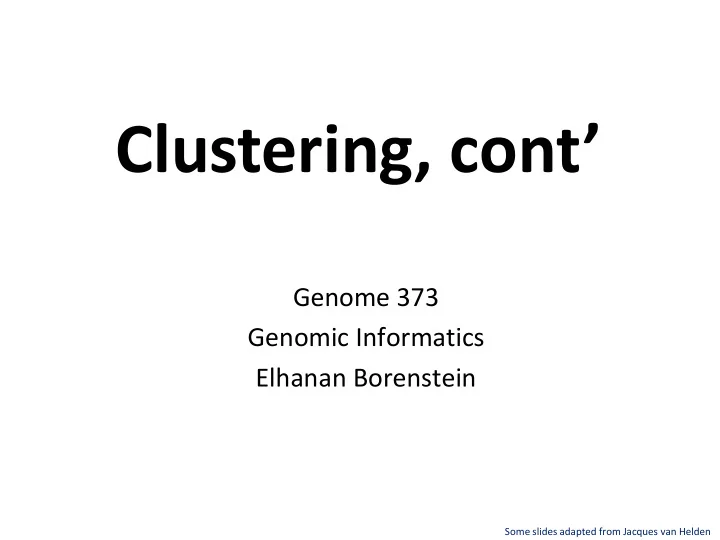

Clustering, cont ’ Genome 373 Genomic Informatics Elhanan Borenstein Some slides adapted from Jacques van Helden
A quick review Improving the search heuristic: Multiple starting points Simulated annealing Genetic algorithms Branch confidence and bootstrap support
A quick review Clustering: The clustering problem: homogeneity vs. separation Why clustering The number of possible clustering solutions gene x [0.1, 0.0, 0.6, 1.0, 2.1, 0.4, 0.2, 0.3, 0.5, 0.1, 2.1] gene y [0.2, 1.0, 0.8, 0.4, 1.4, 0.5, 0.3, 2.1, 1.2, 3.4, 0.1]
One problem, numerous solutions Many algorithms: Hierarchical clustering k-means self-organizing maps (SOM) Knn PCC CLICK There are many formulations of the clustering problem; most of them are NP-hard The results (i.e., obtained clusters) can vary drastically depending on: Clustering method Parameters specific to each clustering method
Different views of clustering …
Different views of clustering …
Different views of clustering …
Different views of clustering …
Different views of clustering …
Different views of clustering …
Measuring similarity/distance An important step in many clustering methods is the selection of a distance measure ( metric ), defining the distance between 2 data points (e.g., 2 genes) “Point” 1 : [0.1 0.0 0.6 1.0 2.1 0.4 0.2] : [0.2 1.0 0.8 0.4 1.4 0.5 0.3] “Point” 2 Genes are points in the multi-dimensional space R n (where n denotes the number of conditions)
Measuring similarity/distance So … how do we measure the distance between two point in a multi-dimensional space? B A
Measuring similarity/distance So … how do we measure the distance between two point in a multi-dimensional space? p-norm Common distance functions: The Euclidean distance 2-norm (a.k.a “distance as the crow flies” or distance). The Manhattan distance 1-norm (a.k.a taxicab distance ) The maximum norm infinity-norm (a.k.a infinity distance ) Correlation (Pearson, Spearman, Absolute Value of Correlation, etc.)
Metric matters! The metric of choice has a marked impact on the shape of the resulting clusters: Some elements may be close to one another in one metric and far from one anther in a different metric. Consider, for example, the point (x=1,y=1) and the origin. What’s their distance using the 2 -norm (Euclidean distance )? What’s their distance using the 1 -norm (a.k.a. taxicab/ Manhattan norm)? What’s their distance using the infinity-norm?
Hierarchical clustering
Hierarchical clustering Hierarchical clustering is an agglomerative clustering method Takes as input a distance matrix Progressively regroups the closest objects/groups Tree representation branch Distance matrix object 1 c1 node object 1 object 2 object 3 object 4 object 5 object 5 c3 object 4 c4 c2 object 1 0.00 4.00 6.00 3.50 1.00 object 2 object 2 4.00 0.00 6.00 2.00 4.50 object 3 object 3 6.00 6.00 0.00 5.50 6.50 root object 4 3.50 2.00 5.50 0.00 4.00 object 5 1.00 4.50 6.50 4.00 0.00 leaf nodes
mmm… Déjà vu anyone?
Hierarchical clustering algorithm 1. Assign each object to a separate cluster. 2. Find the pair of clusters with the shortest distance, and regroup them into a single cluster. 3. Repeat 2 until there is a single cluster. The result is a tree, whose intermediate nodes represent clusters Branch lengths represent distances between clusters
Hierarchical clustering algorithm 1. Assign each object to a separate cluster. 2. Find the pair of clusters with the shortest distance, and regroup them into a single cluster. 3. Repeat 2 until there is a single cluster.
Linkage (agglomeration) methods 1. Assign each object to a separate cluster. 2. Find the pair of clusters with the shortest distance, and regroup them into a single cluster. 3. Repeat 2 until there is a single cluster. One needs to define a (dis)similarity metric between two groups . There are several possibilities Average linkage: the average distance between objects from groups A and B Single linkage: the distance between the closest objects from groups A and B Complete linkage: the distance between the most distant objects from groups A and B
Impact of the agglomeration rule These four trees were built from the same distance matrix, using 4 different agglomeration rules. Single-linkage typically creates nesting clusters Complete linkage create more balanced trees. Note: these trees were computed from a matrix of random numbers. The impression of structure is thus a complete artifact.
Hierarchical clustering result Five clusters
The “philosophy” of clustering “ Unsupervised learning ” problem No single solution is necessarily the true/correct! There is usually a tradeoff between homogeneity and separation: More clusters increased homogeneity but decreased separation Less clusters Increased separation but reduced homogeneity Method matters; metric matters; definitions matter; In most cases, heuristic methods or approximations are used.
Recommend
More recommend